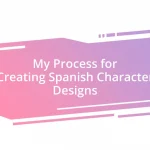Key takeaways:
- Real traditions are essential connections to culture, history, and community, influencing design and evoking emotions.
- Incorporating traditional elements into modern design requires careful research, collaboration with artisans, and an iterative approach to ensure authenticity.
- The emotional impact of blending traditions enhances aesthetic appeal and fosters deeper connections between individuals and their heritage.

Understanding real traditions
Real traditions often emerge from a deep connection to culture, history, and community. I recall visiting a small village where the locals practiced a unique handcraft that had been passed down through generations. It made me wonder, how often do we overlook the stories embedded in our everyday objects?
Traditions aren’t just rituals; they’re expressions of identity and belonging. I remember attending a festival that celebrated a regional custom, and the energy was palpable. It felt like stepping into a living history book, where every dance, song, and dish carried emotional weight. Have you ever experienced a moment where a tradition made you feel truly connected to your roots?
Understanding real traditions involves recognizing their evolution over time. In my travels, I’ve seen how certain traditions adapt while still honoring their origins. This blend of continuity and change fascinates me; it prompts me to ask, how can we honor these traditions while making them relevant in today’s design landscape?

Identifying cultural elements
Identifying cultural elements requires a keen eye for the nuances that make each tradition unique. I remember exploring a bustling market where the vibrant colors of textiles told stories of the artisans who created them. Noticing the intricate patterns, I felt a profound connection to the culture that inspired them. It was a moment that underscored how important it is to recognize and respect the roots of these elements.
When I sift through cultural artifacts, I focus on several key elements:
- Materials Used: The choice of materials often reflects local resources and craftsmanship.
- Symbolism: Many designs carry symbolic meanings deeply rooted in cultural beliefs.
- Color Palettes: Colors can signify different emotions or concepts, varying dramatically between cultures.
- Techniques: Traditional methods of creation can tell stories of survival and innovation.
- Context of Use: Understanding where and how a piece is traditionally used can enrich its significance.
By paying attention to these aspects, I’ve found a deeper appreciation for how culture breathes life into design.

Researching traditional techniques
Researching traditional techniques is like embarking on a treasure hunt, filled with discoveries that often surprise you. I once spent hours in an old workshop where craftsmen demonstrated their skills. Watching their hands work so delicately with ancient tools gave me a profound respect for the techniques that have been refined over centuries. It’s remarkable how each movement holds a story, a history waiting to be told.
When delving into traditional techniques, I find that there’s a wealth of knowledge encoded in the practice itself. I’ve learned that these methods aren’t just about aesthetics; they often address practical needs or constraints present in a culture’s environment. For example, the way a specific weaving pattern in textiles is designed might directly correlate to the climate and available materials. This realization always makes me wonder: How can we utilize these unique techniques in contemporary design while maintaining authenticity?
One of the most enlightening aspects of researching traditional techniques is engaging with the artisans who carry these crafts forward. I remember interviewing an elderly potter who shared how his grandmother taught him not just to shape clay, but to listen to it—each texture and crack holding a memory. This personal connection enriches the art and reminds us that tradition isn’t static; it’s alive and evolving through personal stories and experiences.
| Technique | Purpose |
|---|---|
| Weaving | Creates patterns that reflect cultural significance |
| Ceramics | Utilizes local materials, showcasing heritage |
| Carving | Conveys historical legends and beliefs |

Incorporating traditions into modern design
Blending traditional elements into modern design can be a delicate balancing act. I once redesigned a space using a combination of contemporary furniture and traditional handwoven rugs. The moment those rugs—woven by local artisans—were laid out, the entire room transformed; it felt both fresh and steeped in history. This experience made me realize how traditions can add profound depth to modern aesthetics.
Incorporating these traditions often leads me to ask: How can I ensure that the essence of each culture remains intact? I find that adding traditional motifs or techniques doesn’t just enhance visual appeal, but also prompts narratives that resonate with those who experience the design. For instance, I had a project where I integrated local pottery into kitchen decor, not only providing functional pieces but also sparking conversations about the craft’s origins.
When I reflect on moments like these, I cherish how they connect individuals to a larger story. I remember designing a community space where regional craftsmanship was showcased, and I could see visitors pause to appreciate the care woven into each piece. It was beautiful to witness how tradition could grow and evolve while still honoring its roots, inviting everyone to find their place in the story.

Case studies of successful blends
Many design projects, in my experience, beautifully illustrate how tradition can harmoniously blend with contemporary aesthetics. In one memorable project, I transformed a modern loft by incorporating traditional pottery from a local artisan who had spent decades honing his craft. The clay’s warmth and the intricate patterns told a story that contrasted with the sleek, minimalistic lines of the furniture. This juxtaposition sparked conversations among visitors about the potter’s journey and enriched the overall experience of space—how often does a piece of art encourage storytelling?
Another compelling case I encountered involved the integration of traditional textile designs into fashion collections. A designer I collaborated with once used bold, indigenous patterns in her line, and the result was astonishingly beautiful. As I watched the models walk the runway, it struck me how those patterns were not mere embellishments but symbols of cultural pride. This blend of heritage and innovation resonated deeply with both the audience and the artisans behind the textiles. I often wonder—what can we learn from these moments about the role of culture in our everyday life?
I’ve also tested my ideas in community-centric projects where local artisans participated in design workshops, blending their expertise with modern ideas. One such event featured a group of young designers alongside traditional woodworkers, creating furniture that combined contemporary forms with age-old craftsmanship. The excitement and respect they shared were palpable. This collaborative atmosphere ignited a genuine appreciation for each other’s skills, reminding me how traditions can serve as a bridge, connecting generations and fostering a sense of community. Isn’t it inspiring to think about how design can unite us while honoring the past?

Practical steps for implementation
To effectively blend real traditions into design, start with research. Understanding the history and significance of the traditions you’re incorporating is crucial. I remember a project where I dug deep into local folklore to discover motifs that held meaning for the community. This process not only enriched my design choices but also created a deeper connection with the audience—what stories resonate with them?
Next, I advocate for collaboration with artisans and local craftsmen. On a recent endeavor, I worked hand-in-hand with a weaver to bring traditional textiles into a modern setting. It was inspiring to witness her enthusiasm as she demonstrated techniques passed down through generations. Such collaborations not only ensure authenticity but also offer an enriching experience that brings the design to life—how can we not value this unique exchange of knowledge?
Finally, I suggest applying an iterative approach. Piloting with temporary installations can help you gauge how well traditional elements integrate within a modern context. For instance, I once arranged a pop-up exhibit showcasing traditional art pieces in a sleek urban space. The feedback was illuminating, sparking conversations about identity and heritage in the midst of modernity. It reminded me that the dialogue between old and new is continuous and ever-evolving—how do you envision this conversation unfolding in your designs?

Evaluating the impact on design
Evaluating the impact of blending traditional elements into design gives me pause to reflect on the profound connections established with the audience. I recall an exhibition where traditional music instruments were incorporated into an interactive installation. Visitors weren’t just observers; they were participants, creating melodies that intermingled with contemporary beats. It sparked a conversation not only about the art but also about cultural identities—how often do we get to experience such a living, breathing expression of heritage?
One cannot underestimate how these traditions add layers to aesthetic appeal. For example, on a project that involved using ancient marbling techniques in surface design, I noticed how its rich textures and histories drew people in. Each swirl told a story, enhancing the space’s narrative and aesthetic more than a simple color choice ever could. This makes me wonder—are we sometimes missing the deeper meanings behind designs that seem purely modern?
Moreover, the emotional responses generated through design can lead to unexpected outcomes. I once created a community garden, integrating indigenous planting methods learned from local elders. The residents not only appreciated the beauty of the garden but also felt a revived sense of ownership and pride in their heritage. It compelled me to ask—how can we harness these emotional ties to traditions to elevate our other design pursuits? The answer lies in recognizing that every design decision has the power to create dialogue between the past and the present.














